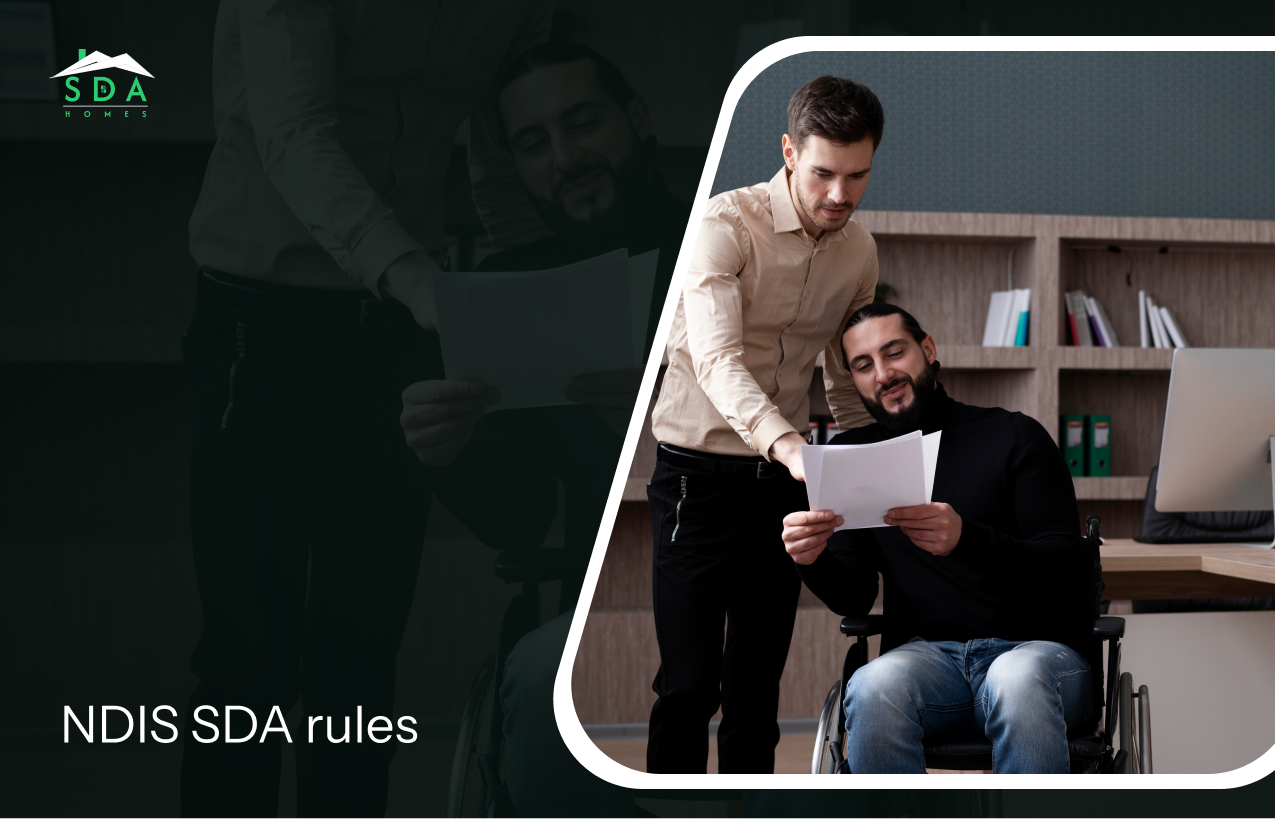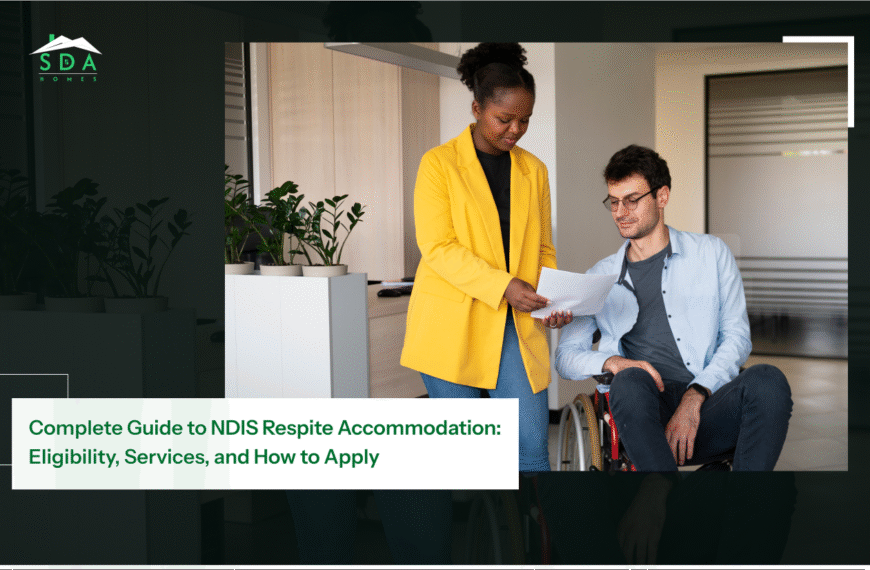The happiness and excitement double the day you move into your desired SDA accommodation. It’s a big step towards a new chapter of your life. Because it’s the first time you will be living in a home designed specifically for your needs, which includes safety, accessibility, and independence. However, amid the mix of hope and nervousness, participants often don’t pay much attention to the transition-phase checklist.
For those participants who are ready to enter into an SDA home, we have brought this SDA accommodation checklist guide to make things easier.
So here we go:
1. Get clear about what you want your life to look like
Before your eligibility, funding letters, design, and floor plans come, your goals, comfort, and future come first. Clarity over these things shapes everything. A lot of participants skip this, but you shouldn’t, if you want a better NDIS SDA experience. So ask the following questions to yourself for complete transparency with yourself and your NDIS provider:
- Do I want to live alone or share with someone?
- How close should I be to family, friends, or my support workers?
- Do I feel better in a quieter area or in a place closer to the action?
- What will help me feel safe, supported, and settled?
2. Check your eligibility and make sure you’ve got the right SDA funding
This part involves paperwork, meetings, discussions, and a lot more custom Q&A sessions, which might feel heavy but not stressful. It is also necessary because having your evidence ready makes the path smoother.
SDA funding sits inside your NDIS plan, so you’ll usually need:
- Functional assessments
- Housing reports
- A clear explanation of why SDA supports your long-term needs
- A Home & Living request (if it hasn’t been done already)
If you’re working with a support coordinator, they’ll guide you through it. And, if you’re not, it’s worth asking an experienced SDA provider, like SDA Homes WA, to help you make sense of the process. They see this every day, so nothing surprises them.
3. Understand the SDA design category that actually fits your needs
Every SDA home falls under a design category such as:
- Improved Livability
- Fully Accessible
- Robust or High Physical Support.
These are like the different comfort levels participants look for as per their requirements. Some people need extra support features. Some want more flexibility. Others want something built for stronger, more durable use. What matters is matching your daily life with the home’s capabilities.
When you walk into a potential SDA home, look at the little things:
- How easy it is to move through hallways
- Whether the bathroom feels usable your way
- If the tech (like automation or call systems) feels intuitive
- That “gut check” of comfort and safety
Those details matter more than the brochure. If your body, mobility, or safety needs change over time, that’s okay. Ask your providers directly for help in figuring out what fits now and what supports your future, too.
4. Make a list of homes and providers that truly get what you need
Not every SDA home is the same. Even if the documents claim they belong to the same category. Some focus on just getting a lot of people in. Others pay more attention to the individuals. And you can notice that difference pretty. This is why picking the right SDA provider is really important.. So when you’re making your list of providers, think about:
- How responsive the provider is
- Whether they explain things in plain language
- How flexible they are about inspections and visits
- Whether they encourage you to bring your support network
- How well they understand WA communities and services
A provider is the team supporting your life. So, pick the people who make you feel seen.
5. Start preparing early (3 to 6 months) before your move
Once you’ve chosen your preferred SDA accommodation, the preparation work starts. In this phase, you need to remain calm to make your move-in as simple and smooth as possible.
You can follow the usual steps:
- Do an in-person or virtual walkthrough
- Measure furniture or equipment to make sure it fits
- Plan how your supports will work in the new space
- Make a list of items you need (storage, bedding, labels, a few creature comforts)
- Check what’s included in the home so you don’t buy things twice
This stage is where excitement starts to build. People begin imagining how the space will look when it’s theirs.
6. One month before moving: the final checks
The last four weeks have gone fast. So in the last moment before moving, tick off a few things like:
- Confirm your move-in date.
- Recheck that any home modifications or tech setups are completed
- Make sure your NDIS supports are aligned with your move
- Tell your support workers (and backup workers) where they need to be
- Start packing things you don’t use daily
Think of this like staging a smooth landing. You want your first days in the home to be calm, not chaotic.
7. Keep it easy on Move-in day: Go at your own pace
Move-in day isn’t really about making everything flawless. It’s more about getting comfortable without feeling stressed. Start wth what you really need:
- Keys and necessary documents
- Medications and important health items
- Bedding
- Chargers, toiletries, and items that make you feel at home
- A scent, photo, or object that feels familiar and comforting
Once you’re in, take a slow walk through your new home. Test things to see how they are working. Ask questions about the usage and timings. Sit in the living room for a moment and just breathe. New spaces feel different for everyone. Permit yourself to take the day at your own pace.
8. The first few weeks: finding your rhythm
Settling into SDA accommodation isn’t just about unpacking boxes. It’s about learning how the space supports your routines.
A few things usually help:
- A check-in with your support coordinator
- Reporting any issues or adjustments needed
- Creating small rituals, morning tea in the kitchen, a walk around the block, even naming your favourite corner of the house
- Introducing yourself to neighbours or nearby services
Remember, you are creating a life, not just filling a space.
9. Living in your home long-term: adjusting to your SDA Place
As time passes, the house starts to feel like your own. You will begin to see what makes you feel relaxed, what personal touches you want to add, and how the aids you have fit into your everyday routine.
Here are a few kind reminders:
- It’s completely normal for your needs to change.
- Make sure to talk openly with your support provider.
- Check your NDIS plan when you need to.
- Contact someone if something doesn’t seem right.
Are You Ready to Move into Your Chosen SDA Homes in WA?
SDA is more than just a place to stay. It’s a move toward being more independent, feeling confident, and having a space that truly suits your lifestyle. At SDA Homes, we realize that moving into an SDA home is about regaining your independence, building your confidence, and improving your overall life, not just changing your address. We provide expert guidance on SDA and NDIS services, helping you choose disability-specific homes that meet your unique housing goals. Schedule a call with our friendly team for a consultation today!
FAQs
1. How much time does it usually take to move into SDA accommodation?
This varies greatly. Some move in within a few weeks of approval. Others take a few months, depending on availability and preparation. Getting the paperwork and financing sorted quickly helps speed things along.
2. Can I decorate or personalise my SDA home?
Most providers encourage it. You can usually bring your furniture, art, bedding, and the things that make a place feel like home. Just check before making structural changes.
3. Do I need SIL to move into SDA?
No. SIL and SDA are separate supports. Some people use both, some don’t. What matters is choosing the support model that fits your life and independence level.
4. What if my needs change after I move in?
Tell your provider and your support coordinator. Many needs can be supported with small adjustments, and bigger changes can be handled through the NDIS review process.
5. Can I move to another SDA home later?
Yes. SDA isn’t a lifetime lock-in. If the home no longer fits your goals or needs, you can explore other options with your support coordinator and provider.












